Microsoft RM-429 GSM Cellular Telephone w/ BT User Manual RM429 NAMLTA630
Microsoft Mobile Oy GSM Cellular Telephone w/ BT RM429 NAMLTA630
Manual
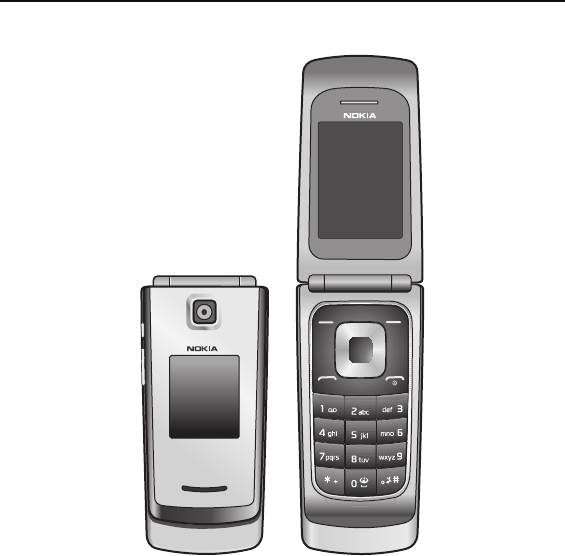
Nokia 3610 fold User Guide
9209385
EN Issue 1
RM429_NAMLTA630.fm Page 1 Monday, June 30, 2008 2:34 PM
FCC Draft

DECLARATION OF CONFORMITY
Hereby, NOKIA CORPORATION declares that this RM-429 product is in
compliance with the essential requirements and other relevant provisions of
Directive 1999/5/EC. A copy of the Declaration of Conformity can be found at
http://www.nokia.com/phones/declaration_of_conformity/.
©2008 Nokia. All rights reserved.
Nokia, Nokia Connecting People, Navi, and Nokia Original Enhancements logo are trademarks or
registered trademarks of Nokia Corporation. Nokia tune is a sound mark of Nokia Corporation. Other
product and company names mentioned herein may be trademarks or tradenames of their respective
owners.
Reproduction, transfer, distribution or storage of part or all of the contents in this document in any form
without the prior written permission of Nokia is prohibited.
US Patent No 5818437 and other pending patents. T9 text input software Copyright (C) 1997-2008. Tegic
Communications, Inc. All rights reserved.
Includes RSA BSAFE cryptographic or security protocol software from RSA Security.
Java is a trademark of Sun Microsystems, Inc.
This product is licensed under the MPEG-4 Visual Patent Portfolio License (i) for personal and
noncommercial use in connection with information which has been encoded in compliance with the
MPEG-4 Visual Standard by a consumer engaged in a personal and noncommercial activity and (ii) for use
in connection with MPEG-4 video provided by a licensed video provider. No license is granted or shall be
implied for any other use. Additional information including that related to promotional, internal, and
commercial uses, may be obtained from MPEG LA, LLC. See http://www.mpegla.com.
Nokia operates a policy of ongoing development. Nokia reserves the right to make changes and
improvements to any of the products described in this document without prior notice.
TO THE MAXIMUM EXTENT PERMITTED BY APPLICABLE LAW, UNDER NO CIRCUMSTANCES SHALL NOKIA
OR ANY OF ITS LICENSORS BE RESPONSIBLE FOR ANY LOSS OF DATA OR INCOME OR ANY SPECIAL,
INCIDENTAL, CONSEQUENTIAL OR INDIRECT DAMAGES HOWSOEVER CAUSED.
THE CONTENTS OF THIS DOCUMENT ARE PROVIDED "AS IS". EXCEPT AS REQUIRED BY APPLICABLE LAW,
NO WARRANTIES OF ANY KIND, EITHER EXPRESS OR IMPLIED, INCLUDING, BUT NOT LIMITED TO, THE
IMPLIED WARRANTIES OF MERCHANTABILITY AND FITNESS FOR A PARTICULAR PURPOSE, ARE MADE IN
RELATION TO THE ACCURACY, RELIABILITY OR CONTENTS OF THIS DOCUMENT. NOKIA RESERVES THE
RIGHT TO REVISE THIS DOCUMENT OR WITHDRAW IT AT ANY TIME WITHOUT PRIOR NOTICE.
The availability of particular products and applications and services for these products may vary by region.
Please check with the Nokia dealer for details, and availability of language options.
0434
RM429_NAMLTA630.fm Page 2 Monday, June 30, 2008 2:34 PM
FCC Draft
Export controls
This device may contain commodities, technology or software subject to export laws and regulations from
the US and other countries. Diversion contrary to law is prohibited.
The third-party applications provided with your device may have been created and may be owned by
persons or entities not affiliated with or related to Nokia. Nokia does not own the copyrights or
intellectual property rights to the third-party applications. As such, Nokia does not take any responsibility
for end-user support, functionality of the applications, or the information in the applications or these
materials. Nokia does not provide any warranty for the third-party applications.
BY USING THE APPLICATIONS YOU ACKNOWLEDGE THAT THE APPLICATIONS ARE PROVIDED AS IS
WITHOUT WARRANTY OF ANY KIND, EXPRESS OR IMPLIED, TO THE MAXIMUM EXTENT PERMITTED BY
APPLICABLE LAW. YOU FURTHER ACKNOWLEDGE THAT NEITHER NOKIA NOR ITS AFFILIATES MAKE ANY
REPRESENTATIONS OR WARRANTIES, EXPRESS OR IMPLIED, INCLUDING BUT NOT LIMITED TO
WARRANTIES OF TITLE, MERCHANTABILITY OR FITNESS FOR A PARTICULAR PURPOSE, OR THAT THE
APPLICATIONS WILL NOT INFRINGE ANY THIRD-PARTY PATENTS, COPYRIGHTS, TRADEMARKS, OR OTHER
RIGHTS.
Check www.nokia.com/support to get the latest version of this guide, contacts, information and
additional services and also to download PC Suite and other software. Consult the nearest service point
and set up your phone.
FCC/INDUSTRY CANADA NOTICE
Your device may cause TV or radio interference (for example, when using a telephone in close proximity to
receiving equipment). The FCC or Industry Canada can require you to stop using your telephone if such
interference cannot be eliminated. If you require assistance, contact your local service facility. This device
complies with part 15 of the FCC rules. Operation is subject to the following two conditions: (1) This
device may not cause harmful interference, and (2) this device must accept any interference received,
including interference that may cause undesired operation. Any changes or modifications not expressly
approved by Nokia could void the user's authority to operate this equipment.
9209385, Issue 1
RM429_NAMLTA630.fm Page 3 Monday, June 30, 2008 2:34 PM
FCC Draft

4
Contents
SAFETY.............................................. 6
Helpful hints ...................................................... 7
About your device............................................. 8
Network services............................................... 9
Shared memory ................................................. 9
Enhancements ................................................... 9
Access codes ................................................... 10
Configuration settings service................... 10
Software updates........................................... 11
Download content......................................... 11
Nokia support ................................................. 11
Digital rights management......................... 12
1. Get started.................................. 12
Install SIM card and battery ..................... 12
Charge the battery ........................................ 13
Switch the phone on and off ..................... 13
Set the time, zone, and date ...................... 13
Antenna............................................................ 13
Connect your phone and PC....................... 14
Keys and parts ................................................ 14
microSD card................................................... 15
Standby mode................................................. 16
Flight mode ..................................................... 18
2. Calls............................................. 18
Make a call...................................................... 18
Call waiting..................................................... 20
Options during a call .................................... 20
3. Write text ................................... 20
Predictive text input..................................... 21
Traditional text input ................................... 21
4. Messaging................................... 21
Write and send a message.......................... 22
Read and reply to a message ..................... 22
Multimedia messages................................... 22
Flash messages............................................... 23
Nokia Xpress audio messaging .................. 23
Memory full..................................................... 23
E-mail application......................................... 24
Instant messaging.......................................... 25
Voice messages............................................... 25
Message settings............................................ 25
5. Contacts ..................................... 27
Search for a contact...................................... 28
Save names and phone numbers............... 28
Save details...................................................... 28
Copy or move contacts................................. 28
Edit contact details........................................ 28
Synchronize all................................................ 29
Delete contacts............................................... 29
Business cards................................................. 29
Settings............................................................. 29
Groups ............................................................... 29
1-touch dialing............................................... 30
6. Log .............................................. 30
7. Settings ...................................... 30
Profiles .............................................................. 30
Themes .............................................................. 30
Tones.................................................................. 31
Main Display.................................................... 31
Mini display ..................................................... 31
Date and time ................................................. 31
My shortcuts.................................................... 32
Connectivity..................................................... 32
Call ..................................................................... 36
Phone................................................................. 36
Enhancements................................................. 37
Accessibility information ............................. 37
Configuration .................................................. 37
Security............................................................. 38
Restore factory settings............................... 38
8. Operator menu........................... 39
9. Gallery ........................................ 39
Print images..................................................... 39
10.Push to talk .............................. 40
RM429_NAMLTA630.fm Page 4 Monday, June 30, 2008 2:34 PM
FCC Draft
5
11.Media......................................... 40
Camera.............................................................. 40
Video.................................................................. 41
Music player.................................................... 41
Voice recorder................................................. 42
Equalizer........................................................... 42
Stereo widening............................................. 42
12.Organizer................................... 43
Alarm clock...................................................... 43
Calendar ........................................................... 43
To-do list.......................................................... 44
Notes................................................................. 44
Calculator......................................................... 44
Countdown timer........................................... 44
Stopwatch........................................................ 45
13.Applications .............................. 45
Launch a game or application ................... 45
Some application options............................ 45
Download an application ............................ 45
14.SIM services .............................. 46
15.Web ........................................... 46
Connect to a service...................................... 46
Bookmarks........................................................ 47
Appearance settings...................................... 47
Security settings............................................. 47
Service inbox ................................................... 48
Browser security............................................. 48
16.PC connectivity......................... 50
Nokia PC Suite ................................................ 50
Packet data, HSCSD, and CSD .................... 50
Bluetooth.......................................................... 50
Data communication applications ............ 50
17.Battery and
charger information ....................... 51
Nokia battery authentication guidelines. 52
Care and maintenance................... 53
Additional safety information ...... 54
RM429_NAMLTA630.fm Page 5 Monday, June 30, 2008 2:34 PM
FCC Draft

6
SAFETY
SAFETY
Read these simple guidelines. Not following them may be dangerous or illegal. Read the
complete user guide for further information.
SWITCH ON SAFELY
Do not switch the device on when wireless phone use is prohibited or when it
may cause interference or danger.
ROAD SAFETY COMES FIRST
Obey all local laws. Always keep your hands free to operate the vehicle while
driving. Your first consideration while driving should be road safety.
INTERFERENCE
All wireless devices may be susceptible to interference, which could affect
performance.
SWITCH OFF IN RESTRICTED AREAS
Follow any restrictions. Switch the device off in aircraft, near medical
equipment, fuel, chemicals, or blasting areas.
QUALIFIED SERVICE
Only qualified personnel may install or repair this product.
ENHANCEMENTS AND BATTERIES
Use only approved enhancements and batteries. Do not connect incompatible
products.
WATER-RESISTANCE
Your device is not water resistant. Keep it dry.
RM429_NAMLTA630.fm Page 6 Monday, June 30, 2008 2:34 PM
FCC Draft

7
General information
General information
■Helpful hints
Before taking your phone to a service point
Q: What can I do to resolve operation issues with my phone?
A: Try the following:
• Switch off the phone; and then remove and re-insert the battery.
• Restore the factory settings. Select Menu > Settings > Rest. factory sett. The names and
phone numbers saved in Contacts are not deleted.
• Update the phone with Nokia Software Updater if available. See www.nokia.com/
softwareupdate or your local Nokia website.
Bluetooth connectivity
Q: Why can’t the phone find a Bluetooth device?
A: Ensure the following:
• Both devices have activated Bluetooth connectivity and are compatible.
• The distance between the two devices is not over 10 meters (33 feet). There are no walls
or other obstructions between the devices.
• The other device is not in the hidden mode.
Calls
Q: How do I change the ringing tone?
A: Select Menu > Settings > Tones.
Contacts
Q: How do I add a new contact?
A: Select Menu > Contacts > Names > Options > Add new contact.
Q: How do I add additional information to a contact?
A: Search for the contact you want, then and select Details > Options > Add detail.
Menus
Q: How can I change the look of the menus?
A: To change the menu view, select Menu > Options > Main menu view.
Q: How do I personalize my menu?
A: To rearrange the menu, select Menu > Options > Organize. Scroll to the menu item you
want to move, and select Move. Scroll to desired spot, and select OK.
RM429_NAMLTA630.fm Page 7 Monday, June 30, 2008 2:34 PM
FCC Draft
8
General information
Messaging
Q: How do I set up e-mail?
A: To use the e-mail function on your phone, you need a compatible e-mail system. Check
your e-mail settings with your e-mail service provider. You may receive the e-mail
configuration settings as a configuration message.
To activate the e-mail settings, select Menu > Messaging > Message settings > E-mail
messages.
PC connectivity
Q: Why do I have problems connecting the phone to my PC?
A: Ensure that Nokia PC Suite is installed and running on your PC. See the Nokia PC Suite
user guide or the help function in Nokia PC Suite. Also, see the support pages at
www.nokia.com.
Shortcuts
Q: Are there any shortcuts on my phone?
A: There are several shortcuts on your phone:
• To access the list of the last dialed or received numbers, press the call key once. Scroll to
the number or name that you want, press the call key.
• To open the web browser, press and hold 0.
• To call your voice mailbox, press and hold 1.
• Use the scroll key as a shortcut. See “My shortcuts”, p. 32.
• To change to the Silent profile or back to the Normal profile, press and hold #.
■About your device
The wireless device described in this guide is approved for use on the EGSM 850 and 900,
and GSM 1800 and 1900 networks. Contact your service provider for more information
about networks.
When using the features in this device, obey all laws and respect local customs, privacy and
legitimate rights of others, including copyrights.
Copyright protection may prevent some images, music, and other content from being
copied, modified, or transferred.
Your device may have preinstalled bookmarks and links for third-party internet sites. You
may also access other third-party sites through your device. Third-party sites are not
affiliated with Nokia, and Nokia does not endorse or assume liability for them. If you choose
to access such sites, you should take precautions for security or content.
Remember to make back-up copies or keep a written record of all important information
stored in your device.
RM429_NAMLTA630.fm Page 8 Monday, June 30, 2008 2:34 PM
FCC Draft

9
General information
When connecting to any other device, read its user guide for detailed safety instructions. Do
not connect incompatible products.
Warning: To use any features in this device, other than the alarm clock, the device
must be switched on. Do not switch the device on when wireless device use may
cause interference or danger.
The availability of some features may vary by region. Please contact your operator for more
details.
■Network services
To use the phone you must have service from a wireless service provider. Many of the
features require special network features. These features are not available on all networks;
other networks may require that you make specific arrangements with your service provider
before you can use the network services. Your service provider can give you instructions and
explain what charges will apply. Some networks may have limitations that affect how you
can use network services. For instance, some networks may not support all language-
dependent characters and services.
Your service provider may have requested that certain features be disabled or not activated
in your phone. If so, these features will not appear on your phone menu. Your phone may
also have a special configuration such as changes in menu names, menu order, and icons.
Contact your service provider for more information.
This device supports WAP 2.0 protocols (HTTP and SSL) that run on TCP/IP protocols. Some
features of this device, such as multimedia messaging (MMS), browsing, e-mail application,
instant messaging, presence enhanced contacts, remote synchronization, and content
downloading using the browser or MMS, require network support for these technologies.
■Shared memory
The following features in this device may share memory: Gallery, contacts, text messages,
multimedia messages, and instant messages, e-mail, calendar, to-do notes, JavaTM games
and applications, and the note application. Use of one or more of these features may reduce
the memory available for the remaining features sharing memory. For example, saving many
Java applications may use all of the available memory. Your device may display a message
that the memory is full when you try to use a shared memory feature. In this case, delete
some of the information or entries stored in the shared memory features before continuing.
■Enhancements
Warning: Use only batteries, chargers, and enhancements approved by Nokia for
use with this particular model. The use of any other types may invalidate any
approval or warranty, and may be dangerous.
RM429_NAMLTA630.fm Page 9 Monday, June 30, 2008 2:34 PM
FCC Draft
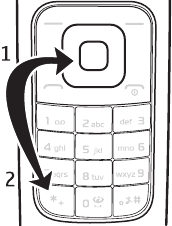
10
General information
For availability of approved enhancements, please check with your dealer. When you
disconnect the power cord of any enhancement, grasp and pull the plug, not the cord.
■Access codes
To set how your phone uses the access codes, select Menu > Settings > Security.
• Keypad lock (keyguard) prevents accidental keypresses:
1. To lock the keypad, with the fold open, select
Menu > * within 3.5 seconds.
2. To unlock the keypad, with the fold open, select
Menu > * within 1.5 seconds.
To answer a call when the keypad is locked, press the
call key. When you end or reject the call, the keypad
locks automatically.
You can also select Menu > Settings > Phone >
Automatic keyguard or Security keyguard > On or Off. If
the security keyguard is on, enter the security code when requested.
• The security code (5-10 digits) protects your phone against unauthorized use. You can
create or change the code; and turn this setting on or off. If you forget the code and the
phone is locked, the phone will require service and additional charges may apply. For
more information, contact a Nokia Care point or your phone dealer.
• The PIN code, supplied with the SIM card, protects the card against unauthorized use.
• The PIN2 code, supplied with some SIM cards, is required to access certain services.
• PUK and PUK2 codes may be supplied with the SIM card. If you enter the PIN or PIN2
code incorrectly three times in succession, you are asked for the PUK or PUK2 code. If you
do not have them, contact your service provider.
• The restriction password (4 digits) is required to restrict calls to and from your phone.
• To view or change the security module settings, if installed, select Menu > Settings >
Security > Security module sett.
■Configuration settings service
To use some of the network services, such as mobile internet services, MMS, Nokia Xpress
audio messaging, or remote internet server synchronization, your phone needs the correct
configuration settings. For availability, contact your network operator, service provider,
nearest authorized Nokia dealer, or see the support pages on www.nokia.com/support.
RM429_NAMLTA630.fm Page 10 Monday, June 30, 2008 2:34 PM
FCC Draft

11
General information
When you have received the settings as a configuration message, and the settings are not
automatically saved and activated, Configuration sett. received is displayed.
To save the settings, select Show > Save. If required, enter the PIN code supplied by the
service provider.
To discard the received settings, select Exit or Show > Discard.
■Software updates
Nokia may produce software updates that may offer new features, enhanced functions, or
improved performance. You may be able to request these updates through the Nokia
Software Updater PC application. To update the device software, you need the Nokia
Software Updater application and a compatible PC with Microsoft Windows 2000 or XP
operating system, broadband internet access, and a compatible data cable to connect your
device to the PC.
To get more information and to download the Nokia Software Updater application, visit
www.nokia.com/softwareupdate or your local Nokia website.
Downloading software updates may involve the transmission of large amounts of data
through your service provider's network. Contact your service provider for information about
data transmission charges.
Your service provider may send phone software updates over the air directly to your device.
This option may not be available, depending on your phone.
Make sure that the device battery has enough power, or connect the charger before starting
the update.
Warning: If you install a software update, you cannot use the device, even to make
emergency calls, until the installation is completed and the device is restarted. Be
sure to back up data before accepting installation of an update.
■Download content
You may be able to download new content (for example, themes) to the phone (network
service). For the availability of different services and pricing, contact your service provider.
Important: Use only services that you trust and that offer adequate security and
protection against harmful software.
■Nokia support
You can find detailed information in the Nokia Warranty and Reference Info booklet/Nokia
Care Services and Warranty Conditions booklet.
RM429_NAMLTA630.fm Page 11 Monday, June 30, 2008 2:34 PM
FCC Draft
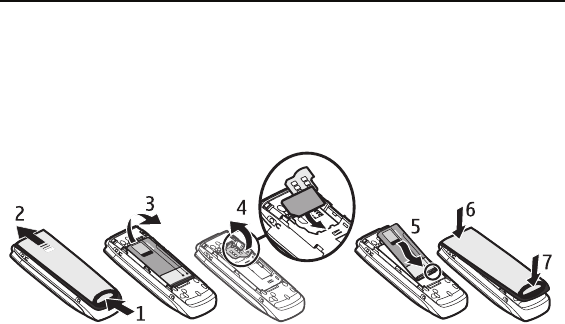
12
Get started
■Digital rights management
Content owners may use different types of digital rights management (DRM) technologies
to protect their intellectual property, including copyrights. This device uses various types of
DRM software to access DRM-protected content. With this device you can access content
protected with WMDRM 10. If certain DRM software fails to protect the content, content
owners may ask that such DRM software’s ability to access the new DRM-protected content
be revoked. Revocation may also prevent renewal of such DRM-protected content already in
your device. Revocation of such DRM software does not affect the use of content protected
with other types of DRM or the use of non-DRM-protected content.
Digital rights management (DRM) protected content comes with an associated activation
key that defines your rights to use the content.
If your device has OMA DRM-protected content, to back up both the activation keys and the
content, use the backup feature of Nokia PC Suite. Other transfer methods may not transfer
the activation keys which need to be restored with the content for you to be able to
continue the use of OMA DRM-protected content after the device memory is formatted. You
may also need to restore the activation keys in case the files on your device get corrupted.
If your device has WMDRM protected content, both the activation keys and the content will
be lost if the device memory is formatted. You may also lose the activation keys and the
content if the files on your device get corrupted. Losing the activation keys or the content
may limit your ability to use the same content on your device again. For more information,
contact your service provider.
1. Get started
■Install SIM card and battery
Always switch the device off and disconnect the charger before removing the battery.
The SIM card and its contacts can easily be damaged by scratches or bending, so be careful
when handling, inserting, or removing the card. Insert the SIM card with the gold-colored
contact area facing down.
RM429_NAMLTA630.fm Page 12 Monday, June 30, 2008 2:34 PM
FCC Draft

13
Get started
■Charge the battery
Your battery has been precharged, but the charging levels may vary.
1. Connect the charger to a wall socket.
2. Connect the charger to your phone.
3. When the battery is fully charged, disconnect the
charger from the phone, then from the wall outlet.
■Switch the phone on and off
1. Press and hold the power key.
2. If the phone asks for a PIN code, enter the code (for example,
displayed as ****), and select OK.
When you switch on your phone for the first time, and the phone is in
the standby mode, you are asked to get the configuration settings
from your service provider. Confirm or decline the query. See
“Configuration”, p. 38, and “Configuration settings service”, p. 10.
■Set the time, zone, and date
When you switch on your phone for the first time, and the phone is in the standby mode, you
are asked to set the time and date. Fill in the fields, and select Save.
To change the time and date settings, select Menu > Settings > Date and time > Date &
time settings, Date and time format, or Auto-update of time (network service).
■Antenna
Your device may have internal and external antennas. As with
any radio transmitting device, avoid touching the antenna
area unnecessarily while the antenna is transmitting or
receiving. Contact with such an antenna affects the
communication quality and may cause the device to operate
at a higher power level than otherwise needed and may reduce
the battery life.
RM429_NAMLTA630.fm Page 13 Monday, June 30, 2008 2:34 PM
FCC Draft
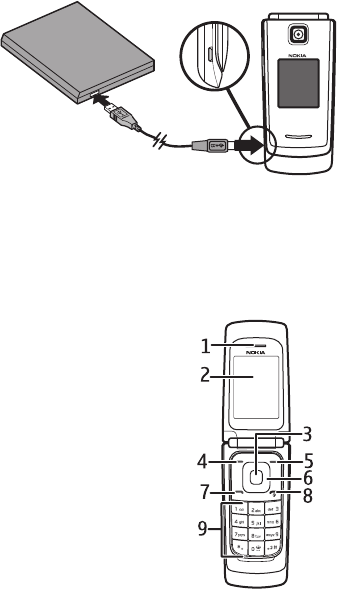
14
Get started
■Connect your phone and PC
The CA-101 data cable is used for
data transfer and synchronizing
your phone and PC. See "Data
transfer," p. 34.
You must download Nokia PC
Suite to use with your device. For
more information, see
www.nokia.com/support.
1. Connect the CA-101 data
cable to the micro USB socket on the lower left side of your phone.
2. Connect the CA-101 data cable to your PC or laptop. USB data cable connected. Select
mode. appears on the display of your phone.
3. Select OK and Default mode.
■Keys and parts
1. Earpiece
2. Main display
3. Middle selection key
4. Left selection key
5. Right selection key
6. Navi™ key; hereafter referred to as a scroll key
7. Call key
8. End key/Power key;
ends calls (press quickly) and
switches the phone on and off (press and hold)
9. Keypad
RM429_NAMLTA630.fm Page 14 Monday, June 30, 2008 2:34 PM
FCC Draft
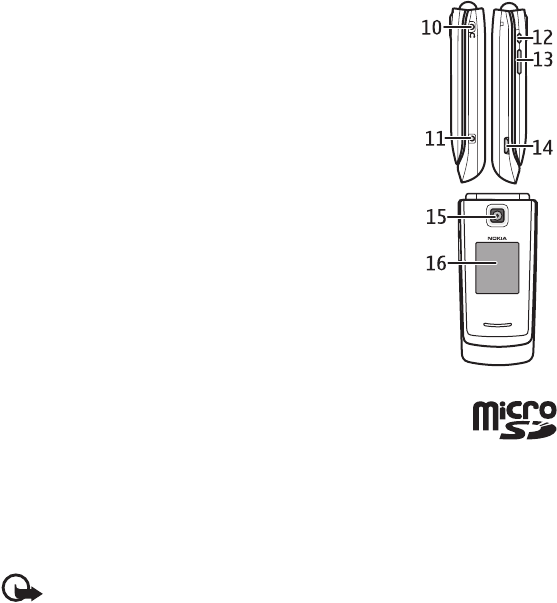
15
Get started
10. Headset connector
11. Charger connector
12. Camera key or PTT key if PTT is activated
13. Volume key
14. USB connector
15. Camera lens
16. Mini display; analogue clock screensaver
■microSD card
The microSD card can be loaded with data such as ringing tones, themes,
tones, images, and videos. If you delete, reload, or replace this card, these
functions and features may not function properly.
Use only compatible microSD cards approved by Nokia for use with this device. Nokia uses
approved industry standards for memory cards, but some brands may not be fully compatible
with this device. Incompatible cards may damage the card and the device and corrupt data
stored on the card.You can remove or replace a microSD card during phone operation
without switching the phone off.
Important: Do not remove the memory card in the middle of an operation when
the card is being accessed. Removing the card in the middle of an operation may
damage the memory card as well as the device, and data stored on the card may
be corrupted.
RM429_NAMLTA630.fm Page 15 Monday, June 30, 2008 2:34 PM
FCC Draft
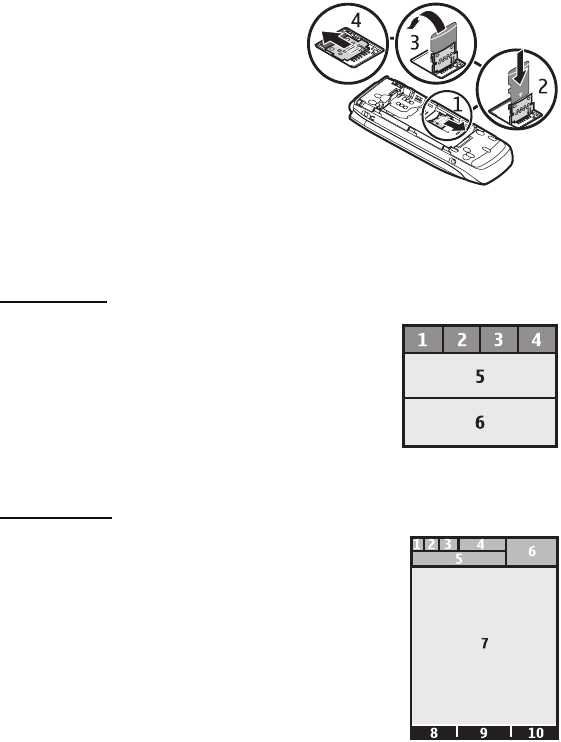
16
Get started
1. Remove the battery cover and battery. Open
the memory card holder.
2. Insert the memory card with the gold-
colored contact area facing up.
3. Swing the card holder back in place.
4. Close the memory card holder. Replace the
back cover.
■Standby mode
When the phone is ready for use, and you have not entered any characters, the phone is in
the standby mode.
Mini display
1Network mode indicator
2Signal strength of the cellular network
3Battery charge status
4Indicators
5Network name or the operator logo
6 Clock and date or profile
Main display
1Network mode indicator
2Signal strength of the cellular network
3Battery charge status
4Indicators
5Network name or the operator logo
6Clock
7Main display
8The left selection key is Go to or a shortcut to another
function. See “Left or right selection key”, p. 32.
9The middle selection key is Menu.
RM429_NAMLTA630.fm Page 16 Monday, June 30, 2008 2:34 PM
FCC Draft

17
Get started
10 The right selection key may be Names to access the list of contacts in the Contacts menu,
an operator-specific name to access an operator-specific website, or a shortcut to a
function you selected. See "My shortcuts," p. 32.
Active standby
In the active standby mode, there is a list of selected phone features and information on the
screen that you can directly access in the standby mode. To switch on or off the mode, select
Menu > Settings > Main display > Active standby > Active standby mode > On or Off.
In the active standby mode, scroll up or down to navigate the list. Left and right arrows at
the beginning and end of a line indicate that further information is available by scrolling left
or right. To end the active standby navigation mode, select Exit.
To organize and change the active standby mode, activate the navigation mode, and select
Options > Personalize view.
Indicators
You have unread messages.
You have new voice mail.
You have unsent, cancelled or failed messages.
You have a missed call.
, Your phone is connected to the instant messaging service, and the availability
status is online or offline.
You received one or several instant messages.
The keypad is locked.
The phone does not ring for an incoming call or text message.
The alarm clock is activated.
The countdown timer is running.
The stopwatch is running.
The phone is registered to the GPRS or EGPRS network.
A GPRS or EGPRS connection is established.
The GPRS or EGPRS connection is suspended (on hold).
Bluetooth connectivity is activated.
RM429_NAMLTA630.fm Page 17 Monday, June 30, 2008 2:34 PM
FCC Draft
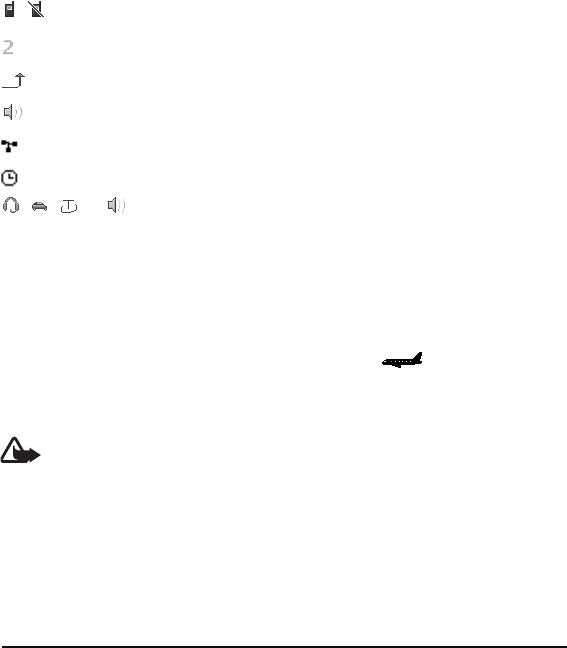
18
Calls
, The push to talk connection is active or suspended.
If you have two phone lines, the second phone line is selected.
All incoming calls are forwarded to another number.
The loudspeaker is activated, or the music stand is connected to the phone.
Calls are limited to a closed user group.
The timed profile is selected.
, , , or
A headset, handsfree, loopset, or music stand enhancement is connected to the
phone.
■Flight mode
You can deactivate all radio frequency functions and still have access to offline games,
calendar, and phone numbers. Use the flight mode in radio sensitive environments — on
board aircraft or in hospitals. When the flight mode is active, is shown.
Select Menu > Settings > Profiles > Flight > Activate or Personalize.
To deactivate the flight mode, select any other profile.
Warning: With the flight profile you cannot make or receive any calls, including
emergency calls, or use other features that require network coverage. To make
calls, you must first activate the phone function by changing profiles. If you need to
make an emergency call while the device is locked and in flight profile you may also
be able to enter an official emergency number programmed in your device in the
lock code field and select Call. The device will confirm that you are about to exit
flight profile to start an emergency call.
2. Calls
■Make a call
1. Enter the phone number, including the area code.
For international calls, press * twice for the international prefix (the + character replaces
the international access code), enter the country code, the area code without the leading
0, if necessary, and the phone number.
The + character as a replacement for the international access code may not work in all
regions. In this case, enter the international access code directly.
RM429_NAMLTA630.fm Page 18 Monday, June 30, 2008 2:34 PM
FCC Draft

19
Calls
2. To call the number, press the call key.
To adjust the volume in a call, press the volume key up or down.
3. To end the call or to cancel the call attempt, press the end key, or close the phone.
For a shortcut to recently dialed numbers, press the call key once in the standby mode. To
call the number, select a number or name, and press the call key.
Answer or reject a voice call
To answer a call, press the call key. To end the call, press the end key.
To reject a call, press the end key.
To mute the ringing tone, select Silence. Then answer or reject the call.
1-touch dialing
Assign a phone number to one of the 1-touch dialing keys, 2-9. See “1-touch dialing”, p. 30.
Call the number in either of the following ways:
• Press a 1-touch dialing key, then the call key.
• If 1-touch dialing is activated, press and hold a 1-touch dialing key until the call begins.
See 1-touch dialing in “Call”, p. 36.
Enhanced voice dialing
Voice dialing allows you to make a call by saying a name in the contact list. Voice commands
are not language-dependent. To set the language, see Voice recognition language in
“Phone”, p. 36.
Note: Using voice tags may be difficult in a noisy environment or during an
emergency, so do not rely solely upon voice dialing.
1. In the standby mode, press and hold the volume key down. A short tone sounds, and
Speak now is displayed.
2. Say the voice command clearly. If the voice recognition was successful, a list with
matches is shown. The phone plays the voice command of the match on the top of the
list. If the result is not the correct one, scroll to another entry.
Using voice commands to carry out a selected phone function is similar to voice dialing.
See Voice commands in “My shortcuts”, p. 32.
RM429_NAMLTA630.fm Page 19 Monday, June 30, 2008 2:34 PM
FCC Draft
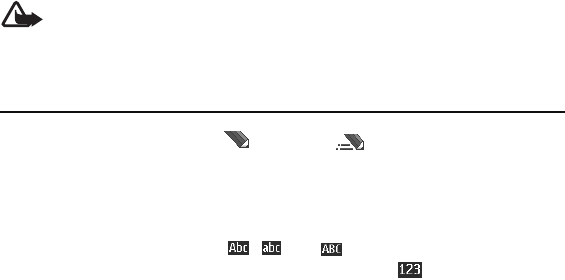
20
Write text
■Call waiting
To answer the waiting call during an active call, select Answer. The first call is put on hold.
To end the active call, press the end key. To switch back to the first call without ending the
second call, select Options > Swap.
To activate the Call waiting function, see “Call”, p. 36.
■Options during a call
Many of the options that you can use during a call are network services. For availability,
contact your service provider.
During a call, select Options and from the following; Mute, Unmute, Contacts, Menu, Lock
keypad, Record, Loudspeaker, or Handset.
Network services options are Answer or Decline, Hold or Unhold, New call, Add to
conference, End call, End all calls, and the following:
Touch tones — to send tone strings
Swap — to switch between the active call and the call on hold
Transfer calls — to connect a call on hold to an active call and disconnect yourself
Conference — to make a conference call of up to five persons
Private call —to discuss privately in a conference call
Warning: Do not hold the device near your ear when the loudspeaker is in use,
because the volume may be extremely loud.
3. Write text
You can enter text using traditional or predictive text input. With traditional
input, you press a key until the correct letter appears. With predictive input, you press the
key once for each letter and let the phone predict the word. When you write text, select and
hold Options to switch between the text input methods. Not all languages are supported by
predictive text input.
The character cases are indicated by , , and . To change the character case,
press #. To change from the letter to number mode, indicated by , press and hold #, and
select Number mode. To change from the number to the letter mode, press and hold #.
To set the writing language, select Options > Writing language.
RM429_NAMLTA630.fm Page 20 Monday, June 30, 2008 2:34 PM
FCC Draft

21
Messaging
■Predictive text input
Tip: To quickly set predictive text input on or off when writing text, press # twice.
To select the prediction input type, select Options > Prediction options > Prediction
type > Normal or Word suggestions.
Predictive text input is based on a built-in dictionary to which you can add new words.
1. Start writing a word using the keys 2 to 9. The phone displays * or the letter if it
separately has a meaning as a word. The entered letters are displayed underlined.
2. When you finish entering the word and it is correct, to confirm it, press 0 to add a space.
If the word is not correct, press * repeatedly, and select the word from the list.
If the ? character is displayed after the word, the word you intended to write is not in the
dictionary. To add the word to the dictionary, select Spell. Enter the word using
traditional text input, and select Save.
To write compound words, enter the first part of the word, and scroll right to confirm it.
Write the last part of the word, and confirm the word.
3. Start writing the next word.
■Traditional text input
Press a number key, 1-9, repeatedly until the desired character appears. The characters
available depend on the selected writing language. Press 0 to create a space. The most
common punctuation marks and special characters are available under the 1 key.
To set traditional text input on, select Options > Prediction options >Prediction > Off.
If the next letter you want is located on the same key you pressed, wait until the cursor
appears before pressing the key again.
4. Messaging
You can read, write, send, and save text, multimedia, e-mail, audio, and flash messages.
Your device supports text messages beyond the limit for a single message. Longer messages
are sent as two or more messages. Your service provider may charge accordingly. Characters
with accents or other marks, and characters from some language options, take up more
space, and limit the number of characters that can be sent in a single message.
An indicator at the top of the display shows the total number of characters left and the
number of messages needed for sending. For example, 673/2 means that there are 673
characters left and that the message is sent as a series of two messages.
RM429_NAMLTA630.fm Page 21 Monday, June 30, 2008 2:34 PM
FCC Draft

22
Messaging
■Write and send a message
1. Select Menu > Messaging > Create message > Message.
2. Enter one or more phone numbers or e-mail addresses in the To: field. To retrieve a phone
number or e-mail address from a memory, select Add.
3. Write your message in the Text: field.
4. To send the message, select Send.
■Read and reply to a message
1. To view a received message, select Show. To view it later, select Exit.
To read the message later, select Menu > Messaging > Inbox.
2. To reply to a message, select Reply. Write the reply message.
3. To send the message, select Send.
■Multimedia messages
Only devices that have compatible features can receive and display multimedia messages.
The appearance of a message may vary depending on the receiving device.
A multimedia message can contain some attachments.
To check availability and to subscribe to the multimedia messaging network service, contact
your service provider.
Write and send a multimedia message
The wireless network may limit the size of MMS messages. If the inserted picture exceeds
this limit, the device may resize it.
1. Select Menu > Messaging > Create message > Message > Options > Change to multim.
2. Enter one or more phone numbers or e-mail addresses in the To: field. To retrieve a phone
number or e-mail address from a memory, select Add.
3. Write your message. To add a file, scroll to the icons at the bottom of the display. Find
the type of file you want, and then select Insert. Scroll to the desired file.
4. To view the message before sending it, select Options > Preview.
5. To send the message, select Send.
RM429_NAMLTA630.fm Page 22 Monday, June 30, 2008 2:34 PM
FCC Draft

23
Messaging
Read and reply to a message
Important: Exercise caution when opening messages. Messages may contain
malicious software or otherwise be harmful to your device or PC.
1. To view a received message, select Show. To view it later, select Exit.
2. To view the whole message if the received message contains a presentation, select Play.
To view the files in the presentation or the attachments, select Options > Objects or
Attachments.
3. To reply to the message, select Options > Reply > Message, E-mail message, Flash
message, or Audio message. Write the reply message.
4. To send the message, select Send.
■Flash messages
Select Menu > Messaging > Create message > Flash message. Enter the recipient’s phone
number, and write your message.
Flash messages are text messages that are instantly displayed upon receipt. Flash messages
are not automatically saved.
■Nokia Xpress audio messaging
You can use MMS to create and send an audio message. MMS must be activated before you
can use audio messages.
1. Select Menu > Messaging > Create message > Audio message. The recorder opens.
2. Speak your message.
3. Enter one or more phone numbers in the To: field, or select Add to retrieve a number.
4. Select Send, or press the call key.
To open a received audio message, select Play. If more than one message is received, select
Show > Play. To listen to the message later, select Exit.
■Memory full
When you receive this message, Memory full. Unable to receive msgs., you must delete some
items. To first delete old messages, select OK > Yes and the folder. Scroll to the desired
message, and select Delete. To delete multiple messages, select Mark. Mark all the messages
you want to delete, and then select Options > Delete marked.
RM429_NAMLTA630.fm Page 23 Monday, June 30, 2008 2:34 PM
FCC Draft

24
Messaging
■E-mail application
Before you can send and retrieve e-mail messages, you must obtain a new e-mail account or
use your current account. To see if your e-mail account is available, contact your e-mail
service provider.
To activate the e-mail settings, select Menu > Messaging > Message settings > E-mail
messages.
To use the e-mail function on your phone, you need a compatible e-mail system.
You may receive the e-mail configuration settings as a configuration message.
E-mail setup wizard
Select Menu > Messaging > E-mail mailbox > Options > Add mailbox >E-mail setup
wizard.
To enter the settings manually, select Menu > Messaging > E-mail mailbox > Options >
Add mailbox > Create manually.
The e-mail application requires an internet access point without a proxy. WAP access points
normally include a proxy and do not work with the e-mail application.
Write and send an e-mail
You can write your e-mail message before connecting to the e-mail service; or connect to
the service first, then write and send your e-mail.
1. Select Menu > Messaging > E-mail message.
2. If more than one e-mail account is defined, select the account from which you want to
send the e-mail.
3. Enter the recipient’s e-mail address, write the subject, and enter the e-mail message. To
attach a file from Gallery, select Options > Insert.
4. To send the e-mail message, select Send > Send now.
Download e-mail
1. To download e-mail messages that have been sent to your e-mail account, select
Menu > Messaging > E-mail > Check new e-mail.
If more than one e-mail account is defined, select the desired account.
The e-mail application only downloads e-mail headers at first.
2. Select Back > Inboxes, the account name, and the new message, and then select
Retrieve to download the complete e-mail message.
RM429_NAMLTA630.fm Page 24 Monday, June 30, 2008 2:34 PM
FCC Draft

25
Messaging
To download new e-mail messages or to send e-mail that has been saved in the Outbox
folder, select Options > Send/check e-mail.
Read and reply to e-mail
Important: Exercise caution when opening messages. E-mail messages may
contain malicious software or otherwise be harmful to your device or PC.
1. Select Menu > Messaging > E-mail > Inboxes, the account name, and the desired
message.
2. To reply to an e-mail, select Reply > Original text. To reply to many, select Options >
Reply to all. Confirm or edit the e-mail address and subject, then write your reply.
3. To send the message, select Send > Send now.
To manage the folders and their e-mail content, select Options to view the available options
of each folder.
■Instant messaging
With instant messaging (IM) (network service) you can send short, simple text messages to
online users. The phone must be connected to the internet, and you must have registered
with the IM service you want to use before you can use this feature. For more information
about signing up for IM services, contact your service provider.
■Voice messages
The voice mailbox is a network service and you may need to subscribe to it. For more
information, contact your service provider.
To call your voice mailbox, select Menu > Messaging > Voice messages > Listen to voice
msgs. To enter, search for, or edit your voice mailbox number, select Voice mailbox number.
If supported by the network, indicates new voice messages. To call your voice mailbox
number, select Listen.
■Message settings
General settings
General settings are common for text and multimedia messages.
Select Menu > Messaging > Message settings > General settings and from the following:
Save sent messages — to set the phone to save the sent messages in the Sent items folder
RM429_NAMLTA630.fm Page 25 Monday, June 30, 2008 2:34 PM
FCC Draft

26
Messaging
Overwriting in Sent — to set the phone to overwrite the old sent messages with the new
ones when the message memory is full, select Allowed. This setting is shown only if you set
Save sent messages > Yes.
Favourite recipients — to select the recipient to appear at the top of selection lists
Font size — to select the font size used in messages
Graphical smileys — to set the phone to replace character-based smileys with graphical ones
Text messages
The text message settings affect the sending, receiving, and viewing of text and SMS
messages.
Select Menu > Messaging > Message settings > Text messages and from the following:
Delivery reports — to ask the network to send delivery reports about your messages
(network service)
Message centers — to set the phone number and name of the message center that is
required for sending text messages, select Add center. You receive this number from your
service provider.
Msg. center in use — to select the message center in use
Message validity — to select the length of time for which the network attempts to deliver
your message
Messages sent via — to select the format of the messages to be sent: Text, Page, or Fax
Use packet data — to set GPRS as the preferred SMS bearer
Character support — to select all characters in the messages to be sent as viewed, select Full.
If you select Reduced, characters with accents and other marks may be converted to other
characters.
Rep. via same center — to allow the recipient of your message to send you a reply using your
message center (network service)
Multimedia messages
The message settings affect the sending, receiving, and viewing of multimedia messages.
You may receive the configuration settings for multimedia messaging as a configuration
message. See “Configuration settings service”, p. 10. You can also enter the settings
manually. See “Configuration”, p. 37.
Select Menu > Messaging > Message settings > Multimedia messages and from the
following:
Delivery reports > Yes — to ask the network to send delivery reports about your messages
(network service)
RM429_NAMLTA630.fm Page 26 Monday, June 30, 2008 2:34 PM
FCC Draft

27
Contacts
MMS creation mode — to restrict or allow various types of multimedia to be added to
messages.
Img. size — to set the image size in multimedia messages
Default slide timing — to define the default time between slides in multimedia messages
Allow MMS receptn. — to receive or block the multimedia message, select Yes or No. If you
select In home network, you cannot receive multimedia messages when outside your home
network. The default setting of the multimedia message service is In home network. The
availability of this menu depends on your phone.
Incoming MMS msgs. — to allow the reception of multimedia messages automatically,
manually after being prompted, or to reject the reception. This setting is not shown if Allow
multimedia reception is set to No.
Allow adverts — to receive or reject advertisements. This setting is not shown if Allow
multimedia reception is set to No, or Incoming multi- media messages is set to Reject.
Configuration sett. — To show only the configurations that support multimedia messaging,
select Configuration. Select a service provider, Default, or Personal config. for multimedia
messaging. Select Account and an MMS account contained in the active configuration
settings.
E-mail messages
The settings affect the sending, receiving, and viewing of e-mail. You may receive the
settings as a configuration message. See “Configuration settings service”, p. 10. You can
also enter the settings manually. See “Configuration”, p. 37.
Select Menu > Messaging > Message settings > E-mail messages and from the following:
New e-mail notif.— to turn new e-mail notification on or off
Allow mail reception — to always allow messages, or only in your home network
Reply with orig. msg. — to reply with the original text in an e-mail
Image size in e-mail — to define the default size of an image in an e-mail
Edit mailboxes — to add, delete, or change the mailboxes in use
5. Contacts
You can save names and phone numbers (contacts) in the phone memory and the SIM card
memory.
The phone memory may save contacts with additional details, such as various phone
numbers and text items. You can also save an image for a limited number of contacts.
RM429_NAMLTA630.fm Page 27 Monday, June 30, 2008 2:34 PM
FCC Draft

28
Contacts
The SIM card memory can save names with one phone number attached to them. The
contacts saved in the SIM card memory are indicated by .
To synchronize from a PC, see "Connectivity," p. 32.
■Search for a contact
Select Menu > Contacts > Names. Scroll through the list of contacts, or enter the first
characters of the name you are searching for.
■Save names and phone numbers
Names and numbers are saved in the used memory. To save a name and phone number,
select Menu > Contacts > Names > Options > Add new contact.
■Save details
In the phone memory, you can save different types of phone numbers, a tone or a video clip,
and short text items for a contact.
The first number you save is automatically set as the default number, and it is indicated with
a frame around the number type indicator (for example, ). When you select a name from
contacts (for example, to make a call), the default number is used unless you select another
number.
Make sure that the memory in use is Phone or Phone and SIM. See “Settings”, p. 29.
Search for the contact to which you want to add a detail, and select Details > Options >
Add detail.
■Copy or move contacts
You can move and copy contacts between the phone and the SIM card memory. The SIM
card can save names with one phone number attached to them.
To move or copy contacts one by one, select Menu > Contacts > Names. Scroll to the
contact, and select Options > Move contact or Copy contact.
To move or copy marked contacts, select Menu > Contacts > Names. Scroll to a contact, and
select Options > Mark. Then mark all other contacts, and select Options > Move marked or
Copy marked.
To move or copy all contacts, select Menu > Contacts > Move contacts or Copy contacts.
■Edit contact details
Search for the contact, and select Details. To edit a name, number, text item, or to change
the image, select Options > Edit. To change the number type, scroll to the desired number,
RM429_NAMLTA630.fm Page 28 Monday, June 30, 2008 2:34 PM
FCC Draft
29
Contacts
and select Options > Change type. To set the selected number as the default number, select
Set as default.
■Synchronize all
Synchronize your calendar, contacts data, and notes with a remote internet server (network
service). For details see “Synchronize from a server”, p. 35.
■Delete contacts
To delete all the contacts and their details from the phone or SIM card memory, select
Menu > Contacts > Del. all contacts > From phone memory or From SIM card.
To delete a contact, search for the desired contact, and select Options > Delete contact.
To delete a number, text item, or an image attached to the contact, search for the contact,
and select Details. Scroll to the desired detail, and select Options > Delete.
■Business cards
You can send and receive a person’s contact information from a compatible device that
supports the vCard standard as a business card.
To send a business card, search for the contact whose information you want to send, and
select Options > Send business card.
When you have received a business card, select Show > Save to save the business card in the
phone memory. To discard the business card, select Exit > Yes.
■Settings
Select Menu > Contacts > Settings and from the following:
Memory in use — to select the SIM card or phone memory for your contacts. Select Phone
and SIM to recall names and numbers from both memories. In that case, when you save
names and numbers, they are saved in the phone memory.
Contacts view — to select how the names and numbers in Contacts are displayed
Name display — to select whether the contact’s first or last name is displayed first
Font size — to set the font size for the list of contacts
Memory status — to view the free and used memory capacity
■Groups
To arrange the names and phone numbers saved in the memory into groups with different
ringing tones and group images, select Menu > Contacts > Groups.
RM429_NAMLTA630.fm Page 29 Monday, June 30, 2008 2:34 PM
FCC Draft

30
Log
■1-touch dialing
To assign a number to a speed-dialing key, select Menu > Contacts > Speed dials, and scroll
to the speed-dialing number you want.
Select Assign, or if a number has already been assigned to the key, select Options > Change.
Select Find and locate the contact you want to assign. If the Speed dials function is off, the
phone asks whether you want to activate it. See also Speed dials in “Call”, p. 36.
To make a call using the speed-dialing keys, see “1-touch dialing”, p. 19.
6. Log
Select Menu > Log > Missed calls, Received calls, or Dialed numbers. To view your recent
missed and received calls and the dialed numbers chronologically, select Call log. To view the
contacts to whom you most recently sent messages, select Msg. recipients.
To view how many text and multimedia messages you have sent and received, select
Menu > Log > Message log.
Note: The actual invoice for calls and services from your service provider may vary,
depending on network features, rounding off for billing, taxes, and so forth.
7. Settings
■Profiles
Your phone has various setting groups called profiles, for which you can personalize the
phone tones for different events and environments.
Select Menu > Settings > Profiles, the desired profile and from the following:
Activate — to activate the selected profile
Personalize — to modify the profile
Timed — to set the profile to be active until a certain time up to 24 hours, and set the end
time. When the time set for the profile expires, the previous profile that was not timed
becomes active.
■Themes
A theme contains elements for personalising your phone.
Select Menu > Settings > Themes and from the following:
RM429_NAMLTA630.fm Page 30 Monday, June 30, 2008 2:34 PM
FCC Draft
31
Settings
Select theme — to set a theme. A list of folders in Gallery opens. Open the Themes folder, and
select a theme.
Theme downloads — to open a list of links to download more themes
■Tones
You can change the tone settings of the selected active profile.
Select Menu > Settings > Tones. You can find the same settings in the Profiles menu.
If you select the highest ringing tone level, the ringing tone reaches its highest level after a
few seconds.
To set the phone to ring only for calls from phone numbers that belong to a selected caller
group, select Alert for. Scroll to the caller group you want or All calls, and select Mark.
Select Options > Save to save the settings or Cancel to leave the settings unchanged.
■Main Display
Select Menu > Settings > Main display and from the available options:
Wallpaper — to add a background image in the standby mode
Active standby — to switch the active standby mode on or off, and to organize and
personalize the active standby mode.
Standby mode font color — to select the color for the texts in the standby mode
Navigation key icons — to display the icons of the current navigation key shortcuts in the
standby mode when active standby is off
Notification details — to display or hide details, such as contact information in a missed call
or message received notifications
Fold animation — to set your phone to display an animation when you open or close the
phone
Font size — to set the font size for messaging, contacts and web pages
Operator logo — to set your phone to display or hide the operator logo
Cell info display — to display the cell identity, if available from the network
■Mini display
Select Menu > Settings > Mini display. You can change the settings for wallpaper, screen
saver, power saver, sleep mode, and fold animation.
■Date and time
To change the time and date settings, select Menu > Settings > Date and time.
RM429_NAMLTA630.fm Page 31 Monday, June 30, 2008 2:34 PM
FCC Draft

32
Settings
■My shortcuts
With personal shortcuts, you can set up quick access to frequently used phone functions.
Left or right selection key
To assign a shortcut to the left or right selection key, select Menu > Settings > My
shortcuts > Left selection key or Right selection key, and then select a function.
Scroll key
To assign other phone functions from a predefined list to the scroll key, select Menu >
Settings > My shortcuts > Navigation key.
Active standby key
To assign the navigation key to access the active standby, select Menu > Settings > My
shortcuts > Active standby key.
Voice commands
Voice commands allow you to say commands to carry out functions instead of pressing keys.
Voice commands are not language-dependent. To set the language, see Voice recognition
language in “Phone”, p. 36.
To select the phone functions to activate with voice commands, select Menu > Settings >
My shortcuts > Voice commands and a folder. Scroll to a function. indicates that the
voice tag is activated. To activate the voice tag, select Add. To play the activated voice
command, select Playback. To use voice commands, see “Enhanced voice dialing”, p. 19.
■Connectivity
You can connect the phone to a compatible device using Bluetooth wireless technology or a
USB data cable. You can also define the settings for EGPRS dial-up connections.
Bluetooth wireless technology
This device is compliant with Bluetooth Specification 2.0 + EDR supporting the following
profiles: generic access, network access, generic object exchange, hands-free, headset,
object push, file transfer, dial-up networking, SIM card access, personal area network
profile, generic audio/video distribution profile, service discovery application profile,
advanced audio and distribution profile, audio/video remote control profile, and serial port.
To ensure interoperability between other devices supporting Bluetooth technology, use
Nokia approved enhancements for this model. Check with the manufacturers of other
devices to determine their compatibility with this device.
RM429_NAMLTA630.fm Page 32 Monday, June 30, 2008 2:34 PM
FCC Draft

33
Settings
There may be restrictions on using Bluetooth technology in some locations. Check with your
local authorities or service provider.
Features using Bluetooth technology or allowing such features to run in the background
while using other features, increase the demand on battery power and reduce the battery
life.
Bluetooth technology allows you to connect the phone to a compatible Bluetooth device
within 10 meters (32 feet). Since devices using Bluetooth technology communicate using
radio waves, your phone and the other devices do not need to be in direct line-of-sight,
although the connection can be subject to interference from obstructions such as walls or
from other electronic devices.
Key message:
• Operating the device in hidden mode is a safer way to avoid malicious software.
• Do not accept Bluetooth connectivity from sources you do not trust.
• Alternatively, switch off the Bluetooth function. This does not affect other functions of
the phone.
Set up a Bluetooth connection
Select Menu > Settings > Connectivity > Bluetooth and from the following:
Bluetooth — to activate or deactivate the Bluetooth function. indicates that the
Bluetooth connectivity is activated. When activating Bluetooth technology for the first
time, you are asked to give a name for the phone. Use a unique name that is easy for others
to identify.
Search for audio enhancements — to search for compatible Bluetooth audio devices. Select
the device that you want to connect to the phone.
Paired devices — to search for any Bluetooth device in range. Select New to list any
Bluetooth device in range. Select a device, and Pair. Enter an agreed Bluetooth passcode of
the device (up to 16 characters) to associate (pair) the device to your phone. You must only
give this passcode when you connect to the device for the first time. Your phone connects to
the device, and you can start data transfer.
If your phone is provided with a hearing aid coil select Hearing aid > T-coil hrng. aid mode >
On to optimize the sound quality when using a t-coil hearing aid. is shown when the T-
coil hrng. aid mode is active.
Bluetooth wireless connection
Select Menu > Settings > Connectivity > Bluetooth. To check which Bluetooth connection
is currently active, select Active devices. To view a list of Bluetooth devices that are currently
paired with the phone, select Paired devices.
RM429_NAMLTA630.fm Page 33 Monday, June 30, 2008 2:34 PM
FCC Draft

34
Settings
Bluetooth settings
To define how your phone is shown to other Bluetooth devices, select Menu > Settings >
Connectivity > Bluetooth > My phone's visibility or My phone's name.
If you are concerned about security, turn off the Bluetooth function, or set My phone's
visibility to Hidden. Always accept only Bluetooth communication from others with whom
you agree.
Packet data
General packet radio service (GPRS) is a network service that allows mobile phones to send
and receive data over an internet protocol (IP)-based network.
To define how to use the service, select Menu > Settings > Connectivity > Packet data >
Packet data conn. and from the following:
When needed — to set the packet data connection when an application needs it. The
connection is closed when the application is terminated.
Always online — to set the phone to automatically connect to a packet data network when
you switch the phone on
Data transfer
Synchronize your calendar, contacts data, and notes with another compatible device (for
example, a mobile phone), a compatible PC, or a remote internet server (network service).
Your phone allows data transfer with a compatible PC or another compatible device when
using the phone without a SIM card.
Transfer contact list
To copy or synchronize data from your phone, the name of the device and the settings must
be in the list of transfer contacts. If you receive data from another device (for example, a
compatible mobile phone), the corresponding transfer contact is automatically added to the
list, using the contact data from the other device. Server sync and PC sync are the original
items in the list.
To add a new transfer contact to the list (for example, a mobile phone), select Menu >
Settings > Connectivity > Data transfer > Options > Add transfer contact > Phone sync or
Phone copy, and enter the settings according to the transfer type.
To edit the copy and synchronize settings, select a contact from the transfer contact list and
Options > Edit.
To delete a transfer contact, select it from the transfer contact list, and Options > Delete.
RM429_NAMLTA630.fm Page 34 Monday, June 30, 2008 2:34 PM
FCC Draft

35
Settings
Data transfer with a compatible device
For synchronization, use Bluetooth wireless technology or a cable connection. The other
device must be activated for receiving data.
To start data transfer, select Menu > Settings > Connectivity > Data transfer and the
transfer contact from the list, other than Server sync or PC sync. According to the settings,
the selected data is copied or synchronized.
Synchronize from a compatible PC
To synchronize data from calendar, notes, and contacts, install the Nokia PC Suite software
for your phone on the PC. Use Bluetooth wireless technology or a USB data cable for the
synchronization, and start the synchronization from the PC.
Synchronize from a server
To use a remote internet server, subscribe to a synchronization service. For more information
and the settings required for this service, contact your service provider. You may receive the
settings as a configuration message. See “Configuration settings service”, p. 10 and
“Configuration”, p. 37.
To start the synchronization from your phone, select Menu > Settings > Connectivity >
Data transfer > Server sync. Depending on the settings, select Initializing sync or Initializing
copy.
Synchronizing for the first time or after an interrupted synchronization may take up to 30
minutes to complete.
USB data cable
You can use the USB data cable to transfer data between the phone and a compatible PC.
You can also use the USB data cable with Nokia PC Suite.
To activate the phone for data transfer or image printing, connect the data cable. Confirm
USB data cable connected. Select mode. and select from the following:
Nokia mode — to use the phone to interact with applications on a PC that has Nokia PC Suite
Printing & Media — to connect the phone to a PC to synchronize it with Windows Media
Player (music, video)
Data storage — to connect to a PC that does not have Nokia software and use the phone as a
data storage
To change the USB mode, select Menu > Settings > Connectivity > USB data cable > Nokia
mode, Printing & Media, or Data storage.
RM429_NAMLTA630.fm Page 35 Monday, June 30, 2008 2:34 PM
FCC Draft
36
Settings
■Call
Select Menu > Settings > Call and from the following:
Call forwarding — to forward your incoming calls (network service). You may not be able to
forward your calls if some call restriction functions are active. See Call restriction in
“Security”, p. 38.
Anykey answer — to answer an incoming call by briefly pressing any key, except the power
key, the camera key, the left and right selection keys, or end key
Automatic redial — to make a maximum of 10 attempts to connect the call after an
unsuccessful call attempt
Voice clarity — to enhance speech intelligibility especially in noisy environments, select
Active.
1-touch dialing — to dial the names and phone numbers assigned to the speed-dialing keys
2-9 by pressing and holding the corresponding number key
Call waiting — to have the network notify you of an incoming call while you have a call in
progress (network service), select Activate. See "Call waiting," p. 20.
Summary after call — to briefly display the approximate duration and cost (network service)
of the call after each call
Send my caller ID — to show your phone number to the person you are calling (network
service). To use the setting agreed upon with your service provider, select Set by network.
Answ. if fold is opened — to answer an incoming call by opening the fold.
■Phone
Select Menu > Settings > Phone and from the following:
Language settings — to set the display language of your phone, select Phone language.
Select Automatic to set the language according to your SIM card. To set a language for the
voice playback, select Voice recognition language. See “Enhanced voice dialing”, p. 19 and
Voice commands in “My shortcuts”, p. 32.
Memory status — to view the amount of used and available phone memory
Automatic keyguard — to set the keypad of your phone to lock automatically after a preset
time delay when the phone is in the standby mode and no function is in use. Select On, and
set the time.
Security keyguard — to set the phone to ask for the security code when you unlock the
keyguard. Enter the security code, and select On.
Welcome note — to write the note that is shown when the phone is switched on
Phone updates — to check current software or install software updates
RM429_NAMLTA630.fm Page 36 Monday, June 30, 2008 2:34 PM
FCC Draft

37
Settings
Operator selection — to set the phone to automatically select one of the cellular networks
available in your area, select Automatic. Select Manual to choose a network that has a
roaming agreement with your service provider.
Help text activation — to select whether the phone shows help texts
Start-up tone — the phone plays a tone when switched on
Fold close handling — to select whether to return to standby mode, or keep all applications
open when the fold is closed
Flight query — the phone asks whether to use the flight profile every time when switched on.
See "Flight mode," p. 18.
■Enhancements
The following options are shown only if the phone is or has been connected to a compatible
mobile enhancement.
Select Menu > Settings > Enhancements. Select an enhancement, and depending on the
enhancement, from the following:
Charger/Default profile — to select the profile that you want to be automatically activated
when you connect to the selected enhancement
Charger/Lights — to set the lights permanently On. To set the lights on for 15 seconds after a
key press, select Automatic.
Hearing aid > T-coil hrng. aid mode — to optimize the sound quality when using a T-coil
hearing aid. is shown when the T-coil hearing aid mode is active.
■Accessibility information
Nokia is commited to making mobile phones easy to use for all individuals, including those
disabilities. For more information, visit the web site at www.nokiaaccessibility.com.
■Configuration
You can configure your phone with settings required for certain services to function
correctly. Your service provider may also send you these settings. See “Configuration
settings service”, p. 10.
Select Menu > Settings > Configuration and from the following:
Default config. sett. — to view the service providers saved in the phone. To set the
configuration settings of the service provider as default settings, select Options > Set as
default.
Activ. def. in all apps. — to activate the default configuration settings for supported
applications
RM429_NAMLTA630.fm Page 37 Monday, June 30, 2008 2:34 PM
FCC Draft
38
Settings
Connect to support — to download the configuration settings from your service provider
Personal config. sett. — to add new personal accounts for various services manually, and to
activate or delete them. To add a new personal account if you have not added any, select
Add new; otherwise, select Options > Add new. The parameters differ according to the
selected service type.
■Security
When security features that restrict calls are in use (such as call restriction, closed user
group, or fixed dialing), calls still may be possible to the official emergency number
programmed into your phone.
Select Menu > Settings > Security and from the following:
PIN code request — to set the phone to ask for your PIN code every time the phone is
switched on. Some SIM cards do not allow the code request to be turned off.
PIN2 code request — to select whether the PIN2 code is required when using a specific phone
feature which is protected by the PIN2 code. Some SIM cards do not allow the code request
to be turned off.
Call restriction service — to restrict incoming calls to and outgoing calls from your phone
(network service). A restriction password is required.
Fixed dialing — to restrict your outgoing calls to selected phone numbers if this function is
supported by your SIM card. When the fixed dialing is on, GPRS connections are not possible
except while sending text messages over a GPRS connection. In this case, the recipient’s
phone number and the message center number must be included in the fixed dialing list.
Closed user group — to specify a group of people whom you can call and who can call you
(network service)
Security level — to set the phone to ask for the security code whenever a new SIM card is
inserted into the phone, select Phone. If you select Memory, the phone asks for the security
code when the SIM card memory is selected, and you want to change the memory in use.
Access codes — to change the security code, PIN code, PIN2 code, or restriction password
Authority certificates or User certificates — to view the list of the authority or user
certificates downloaded into your phone. See “Certificates”, p. 49.
Security module sett. — to view security module details, select Module PIN request, or
change the module PIN and signing PIN. See also “Access codes”, p. 10.
■Restore factory settings
To reset some of the menu settings to their original values, select Menu > Settings > Rest.
factory sett > Restore Settings Only. Enter the security code. If you have not created a
RM429_NAMLTA630.fm Page 38 Monday, June 30, 2008 2:34 PM
FCC Draft

39
Operator menu
security code, the phone will prompt you to create one. The names and phone numbers
saved in Contacts, are not deleted.
8. Operator menu
This menu lets you access services provided by your network operator. The name and the
icon depend on the operator. For more information, contact your network operator.
Select Menu > Messaging > Info messages to receive messages on various topics from your
service provider (network service). For more information, contact your service provider.
Select Menu > Messaging > Serv. commands to write and send service requests (USSD
commands) to your service provider, such as activation commands for network services.
9. Gallery
In this menu, you can manage images, video clips, music files, themes, graphics, tones,
recordings, and received files. Files are stored in the phone memory or an attached microSD
card and may be arranged in folders.
Your phone supports an activation key system to protect acquired content. Always check the
delivery terms of any content and activation key before acquiring them, as they may be
subject to a fee.
Copyright protections may prevent some images, music (including ringing tones), and other
content from being copied, modified, transferred, or forwarded.
To see the list of folders, select Menu > Gallery.
To view the list of files in a folder, select the folder, and then Open.
To view the folders of the memory card when moving a file, scroll to the memory card, and
press the scroll key right.
■Print images
Your device supports Nokia XpressPrint. To connect it to a compatible printer, use a data
cable or send the image via Bluetooth connection to a printer supporting Bluetooth
technology. See “Connectivity”, p. 32.
You can print images that are in the JPG format. The images captured with the camera are
automatically saved in the JPG format.
Select the image you want to print and Options > Print.
RM429_NAMLTA630.fm Page 39 Monday, June 30, 2008 2:34 PM
FCC Draft

40
Push to talk
10. Push to talk
With Push to talk (PTT) (network service), you can talk with one person or with a group of
people (channel) having compatible devices. You have to subscribe to a service and register
with the PTT service you want to use. For more information about PTT services, contact your
service provider. The availability of some features may vary by region, so you may not have
access to this feature.
Select Menu > Push to talk.
11. Media
When capturing and using images or video clips, obey all laws and respect local customs as
well as privacy and legitimate rights of others, including copyrights.
You can capture images or record live video clips with the built-in
1.3-megapixel camera.
■Camera
The camera produces pictures in the JPEG format and video clips in 3GPP format. The camera
lens is on the front of the phone. The color display works as a viewfinder.
Capture an image
To open the camera viewfinder, select Menu > Media > Camera.
To zoom in and out in the camera mode, press volume keys up or down.
To capture an image, select Capture, or press the camera key. The phone saves the images on
the memory card.
If the lighting is dim, select Options > Night mode.
To take a sequence of images quickly, select Options > Img. sequence. Three to eight images
are taken depending on the image size.
To display an image immediately after you take it, select Options > Settings > Image
preview time and the preview time. During the preview time, select Back to take another
image or Send to send the image as a multimedia message.
Your phone supports an image capture resolution of 1024 x 1280 pixels.
Camera and video options
To use a filter, select Options > Effects > Normal, Grayscale, Sepia, or Negative.
RM429_NAMLTA630.fm Page 40 Monday, June 30, 2008 2:34 PM
FCC Draft

41
Media
To change the camera and video settings, select Options > Settings.
■Video
You can record video clips in 3GPP format. The available recording time depends on the
video clip length and quality settings.
The length and file size of the clips may vary depending on the selected quality and available
memory. To set the quality of your video clips, select Menu > Media > Video > Options >
Settings >Video clip quality > High, Normal or Basic.
To select the file size limit, select Menu > Media > Video > Options > Settings > Video clip
length. Default means that the file size is limited so that it fits into a multimedia message
(multimedia message size can vary among devices). Maximum means that all available
memory is used. The available memory depends on where the video clip is stored.
Record a video clip
Select Menu > Media > Video > Record. You can also press and hold the camera key. To
pause the recording, select Pause; to resume the recording, select Continue. To stop the
recording, select Stop. The phone saves the recording in Gallery > Video clips.
To zoom in or out, press the volume key up or down, or scroll left and right.
■Music player
Your phone includes a music player for listening to songs, recordings or, other sound files
that you have transferred to the phone with the Nokia Audio Manager application, which is
part of Nokia PC Suite. See “Nokia PC Suite”, p. 50.
Music files stored in a folder in the phone or memory card are automatically added to the
default playlist.
To open the music player, select Menu > Media > Music player.
Play music
Warning: Listen to music at a moderate level. Continuous exposure to high volume
may damage your hearing. Do not hold the device near your ear when the
loudspeaker is in use, because the volume may be extremely loud.
Operate the music player with the keys on the phone or with the virtual keys on the
display.
When you open the Music player menu, the details of the first song on the default playlist
are shown. To play, select .
To adjust the volume level, use the volume keys on the side of the phone.
To pause the playing, select .
RM429_NAMLTA630.fm Page 41 Monday, June 30, 2008 2:34 PM
FCC Draft

42
Media
To stop the playing, press and hold the end key
To skip to the next song, select . To skip to the beginning of the previous song, select
.
To rewind the current song, select and hold . To fast forward the current song, select
and hold . Release the key at the position you want.
■Voice recorder
You can record pieces of speech, sound, or an active call, and save them in Gallery. This is
useful when recording a name and phone number to write down later.
The recorder cannot be used when a data call or GPRS connection is active.
Record sound
1. Select Menu > Media > Voice recorder.
To use the graphical keys , , or on the display, scroll left or right to the desired
key, and select it.
2. To start the recording, select . To start the recording during a call, select Options >
Record. While recording a call, all parties hear a faint beeping sound. When recording a
call, hold the phone in the normal position near to your ear. To pause the recording,
select .
3. To end the recording, select . The recording is saved in Gallery > Recordings.
To listen to the latest recording, select Options > Play last recorded.
To send the last recording, select Options > Send last recorded.
To see the list of recordings in Gallery, select Options > Recordings list > Recordings.
■Equalizer
To change the bass frequency bands that you hear with the music player. Select Menu >
Media > Equalizer.
To activate a set designed to enhance a type of music, scroll to one of the equalizer sets, and
select Activate.
■Stereo widening
Stereo widening enhances the audio output of the phone by enabling a wider stereo sound
effect. To change the setting, select Menu > Media > Stereo widening.
RM429_NAMLTA630.fm Page 42 Monday, June 30, 2008 2:34 PM
FCC Draft

43
Organizer
12. Organizer
■Alarm clock
You can set the phone to alarm at a desired time. Select Menu > Organizer > Alarm clock.
To set the alarm, select Alarm time, and enter the alarm time. To change the alarm time
when the alarm time is set, select On.
To set the phone to alert you on selected days of the week, select Repeat alarm.
To select the alarm tone, select Alarm tone:.
To set a snooze time-out, select Snooze time-out and the time.
Stop the alarm
The phone sounds an alert tone even if the phone was switched off. To stop the alarm, select
Stop. If you let the phone sound the alarm for a minute or select Snooze, the alarm stops for
the time you set in Snooze time-out, then resumes.
■Calendar
Select Menu > Organizer > Calendar.
The current day is indicated by a frame. If there are any notes set for the day, the day is in
bold, and the beginning of the note is shown below the calendar. To view the day notes,
select View. To view a week, select Options > Week view. To delete all notes in the calendar,
select the month or week view, and then select Options > Delete all notes.
To change time and date information, select Settings.
To set the phone to delete old notes automatically after a specified time, select Auto-delete
notes.
Make a calendar note
Select Menu > Organizer > Calendar. Scroll to the date, and select Options > Make a note
and one of the following note types: Reminder, Meeting, Call, Birthday,
or Memo. Fill in the fields.
Note alarm
The phone displays the note, and if set, sounds a tone. With a call note on the display, to
call the displayed number, press the call key. To stop the alarm and to view the note, select
View. To stop the alarm for 10 minutes, select Snooze.
To stop the alarm without viewing the note, select Exit.
RM429_NAMLTA630.fm Page 43 Monday, June 30, 2008 2:34 PM
FCC Draft

44
Organizer
■To-do list
To save a note for a task that you must do, select Menu > Organizer > To-do list.
To make a note if no note is added, select Add note. Fill in the fields, and select Save.
To view a note, scroll to it, and select View. While viewing a note, you can edit the attributes.
You can also delete the selected note and delete all the notes that you have marked as done.
■Notes
To write and send notes, select Menu > Organizer > Notes. To make a note if no note is
added, select Add note. Write the note, and select Save.
■Calculator
The calculator in your phone provides basic functions.
Note: This calculator has limited accuracy and is designed for simple calculations.
Select Menu > Organizer > Calculator. When 0 is displayed on the screen, enter
the first number in the calculation. Press # for a decimal point. Scroll to the desired
operation or function or select it from the Options. Enter the second number. Repeat this
sequence as many times as necessary. To start a new calculation, first select, and hold Clear.
To perform a currency conversion, select Menu > Organizer > Calculator. To save the
exchange rate, select Options > Exchange rate. Select either of the displayed options. Enter
the exchange rate, press # for a decimal point, and select OK. To perform the currency
conversion, enter the amount to be converted, and select Options > To home or To foreign.
Note: When you change base currency, you must enter new exchange rates
because all previously set exchange rates are cleared.
■Countdown timer
1. To activate the countdown timer, select Menu > Organizer > Countd. timer > Normal
timer, enter the alarm time, and write a note that is displayed when the time expires. To
change the countdown time, select Change time.
2. To start the timer, select Start.
3. To stop the timer, select Stop timer.
Interval timer
1. To have an interval timer with up to 10 intervals started, first enter the intervals.
2. Select Menu > Organizer > Countd. timer > Interval timer.
3. To start the timer, select Start timer > Start.
RM429_NAMLTA630.fm Page 44 Monday, June 30, 2008 2:34 PM
FCC Draft

45
Applications
■Stopwatch
You can measure time, take intermediate times, or take lap times using the stopwatch.
During timing, you can use the other functions of the phone.
Select Menu > Organizer > Stopwatch and from the following:
Split timing — to take intermediate times. To start the time observation, select Start. Select
Split every time you want to take an intermediate time. To stop the time observation, select
Stop.
To start the time observation again, select Options > Start. The new time is added to the
previous time. To reset the time without saving it, select Reset.
To save the measured time, select Save.
Lap timing — to take lap times
To set the stopwatch timing in the background, press the end key. Select Continue to view
the timing in the background.
13. Applications
This menu allows you to manage your applications and games. These files are stored in the
phone memory or in a microSD card.
■Launch a game or application
To launch a game, select Menu > Applications > Games. Scroll to the desired game, and
select Open. To launch an application, select Menu> Applications > Collection. Scroll to an
application, and select Open.
■Some application options
Update version — to check if a new version of the application is available for download from
web (network service)
Web page — to provide further information or additional data for the application from a web
page (network service), if available
App. access — to restrict the application from accessing the network
■Download an application
Your phone supports J2ME Java applications. Make sure that the application is compatible
with your phone before downloading it.
RM429_NAMLTA630.fm Page 45 Monday, June 30, 2008 2:34 PM
FCC Draft

46
SIM services
Important: Only install and use applications and other software from trusted
sources, such as applications that are Symbian Signed or have passed the Java
VerifiedTM testing.
You can download new Java applications and games in different ways.
Use the Nokia Application Installer from PC Suite to download the applications to your
phone, or select Menu > Applications > Options > Downloads > App. downloads; the list of
available bookmarks is shown. See “Bookmarks”, p. 47.
For availability and pricing, contact your service provider.
14. SIM services
Your SIM card may provide additional services. You can access this menu only if it is
supported by your SIM card. The name and contents of the menu depend on the available
services. Accessing these services may involve sending messages or making a phone call for
which you may be charged.
15. Web
You can access various mobile internet services with your phone browser.
Important: Use only services that you trust and that offer adequate security and
protection against harmful software.
For availability, pricing, tariffs, and instructions, contact your service provider.
You can view the services that use wireless markup language (WML) or extensible hypertext
markup language (XHTML) on their pages with the phone browser. Appearance may vary due
to screen size. You may not be able to view all details of the web pages.
■Connect to a service
Ensure that the correct configuration settings of the service are activated.
To select the settings for connecting to the service:
1. Select Menu > Web > Settings > Configuration sett.
2. Select Configuration. Only the configurations that support browsing service are shown.
Select a service provider, Default, or Personal config. for browsing.
You may receive the configuration settings required for browsing as a configuration
message from the service provider that offers the service.
RM429_NAMLTA630.fm Page 46 Monday, June 30, 2008 2:34 PM
FCC Draft

47
Web
3. Select Account and a browsing service account contained in the active configuration
settings.
4. Select Displ. term. window > Yes to perform manual user authentication for intranet
connections.
Make a connection to the service in one of the following ways:
•Select Menu > Web > Home; or in the standby mode, press and hold 0.
• To select a bookmark of the service, select Menu > Web > Bookmarks.
• To select the last URL, select Menu > Web > Last web addr.
• To enter the address of the service, select Menu > Web > Go to address. Enter the
address of the service, and select OK.
■Bookmarks
You can save web addresses as bookmarks in the phone memory.
1. While browsing, select Options > Bookmarks.
2. Scroll to a bookmark, and select it, or press the call key to make a connection to the page
associated with the bookmark.
3. Select Options to view, edit, delete, or send the bookmark; to create a new bookmark; or
to save the bookmark to a folder.
■Appearance settings
To personalize the way web pages are displayed on your phone, while browsing, select
Options > Other options > Appearance settings.
■Security settings
Cookies and cache
A cookie is data that a site saves in the cache memory of your phone. Cookies are saved until
you clear the cache memory.
While browsing, select Options > Other options > Security > Cookie settings. To allow or
prevent the phone from receiving cookies, select Allow or Reject.
A cache is a memory location that is used to store data temporarily. If you have tried to
access or have accessed confidential information requiring passwords, empty the cache
after each use. The information or services you have accessed are stored in the cache. To
empty the cache, select Options > Other options > Clear the cache.
RM429_NAMLTA630.fm Page 47 Monday, June 30, 2008 2:34 PM
FCC Draft

48
Web
Scripts over secure connection
You can select whether to allow the running of scripts from a secure page. The phone
supports WML scripts.
While browsing, to allow the scripts, select Options > Other options > Security >
WMLScript sett.
■Service inbox
The phone is able to receive service messages sent by your service provider (network service).
Service messages are notifications (for example, news headlines), and they may contain a
text message or an address of a service.
To access the Service inbox in the standby mode, when you have received a service message,
select Show. If you select Exit, the message is moved to the Service inbox. To access the
Service inbox later, select Menu > Web > Service inbox.
Service inbox settings
Select Menu > Web > Settings > Service inbox settings.
To set whether you want to receive service messages, select Service messages > On or Off.
To set the phone to receive service messages only from content authors approved by the
service provider, select Message filter > On. To view the list of the approved content authors,
select Trusted channels.
To set the phone to automatically activate the browser from the standby mode when the
phone has received a service message, select Automatic connection > On. If you select Off,
the phone activates the browser only after you select Retrieve when the phone has received
a service message.
■Browser security
Security features may be required for some services, such as online banking or shopping. For
such connections, you need security certificates and possibly a security module, which may
be available on your SIM card. For more information, contact your service provider.
Security module
The security module improves security services for applications requiring a browser
connection, and allows you to use a digital signature. The security module may contain
certificates as well as private and public keys. The certificates are saved in the security
module by the service provider.
To view or change the security module settings, select Menu > Settings > Security >
Security module settings.
RM429_NAMLTA630.fm Page 48 Monday, June 30, 2008 2:34 PM
FCC Draft

49
Web
Certificates
Important: Even if the use of certificates makes the risks involved in remote
connections and software installation considerably smaller, they must be used
correctly in order to benefit from increased security.
The existence of a certificate does not offer any protection by itself; the certificate manager
must contain correct, authentic, or trusted certificates for increased security to be available.
Certificates have a restricted lifetime. If "Expired certificate" or "Certificate not valid yet" is
shown even if the certificate should be valid, check that the current date and time in your
device are correct.
Before changing any certificate settings, you must make sure that you really trust the owner
of the certificate and that the certificate really belongs to the listed owner.
There are three kinds of certificates: server certificates, authority certificates, and user
certificates. You may receive these certificates from your service provider. Authority
certificates and user certificates may also be saved in the security module by the service
provider.
To view the list of the authority or user certificates downloaded into your phone, select
Menu > Settings > Security > Authority certificates or User certificates.
is displayed during a connection, if the data transmission between the phone and the
content server is encrypted.
The security icon does not indicate that the data transmission between the gateway and the
content server (or place where the requested resource is stored) is secure. The service
provider secures the data transmission between the gateway and the content server.
Digital signature
You can make digital signatures with your phone if your SIM card has a security module.
Using the digital signature can be the same as signing your name to a paper bill, contract, or
other document.
To make a digital signature, select a link on a page, for example, the title of the book you
want to buy and its price. The text to sign, which may include the amount and date, is
shown.
Check that the header text is Read and that the digital signature icon is shown.
Note: If the digital signature icon does not appear, there is a security breach, and you should
not enter any personal data such as your signing PIN.
To sign the text, read all of the text first, and select Sign.
The text may not fit within a single screen. Therefore, make sure to scroll through and read
all of the text before signing.
RM429_NAMLTA630.fm Page 49 Monday, June 30, 2008 2:34 PM
FCC Draft

50
PC connectivity
Select the user certificate you want to use. Enter the signing PIN. The digital signature icon
disappears, and the service may display a confirmation of your purchase.
16. PC connectivity
You can send and receive e-mail, and access the internet when your phone is connected to a
compatible PC through a Bluetooth or data cable connection. You can use your phone with a
variety of PC connectivity and data communications applications.
■Nokia PC Suite
With Nokia PC Suite, you can synchronize contacts, calendar, notes, and to-do notes
between your phone and a compatible PC or a remote internet server (network service). You
may find more information and PC Suite on the Nokia website at www.nokia.com/support or
your local Nokia website.
■Packet data, HSCSD, and CSD
With your phone, you can use the packet data, high-speed circuit switched data (HSCSD),
and circuit switched data (CSD, GSM data) data services. For availability and subscription to
data services, contact your network operator or service provider. The use of HSCSD services
consumes the phone battery faster than normal voice or data calls.
■Bluetooth
Use the Bluetooth technology to connect your compatible laptop to the internet. Your phone
must have activated a service provider that supports internet access and your PC has to
support Bluetooth technology PAN (personal area network profile). After connecting to the
network access point (NAP) service of the phone and pairing with your PC your phone
automatically opens a packet data connection to the internet. PC Suite software installation
is not necessary when using the NAP service of the phone. See “Bluetooth wireless
technology”, p. 32.
■Data communication applications
For information on using a data communication application, see the product’s
documentation. Making or answering phone calls during a computer connection is not
recommended, as it might disrupt the operation.
For better performance during data calls, place the phone on a stationary surface with the
keypad facing downward. Do not move the phone by holding it in your hand during a data
call.
RM429_NAMLTA630.fm Page 50 Monday, June 30, 2008 2:34 PM
FCC Draft

51
Battery and charger information
17. Battery and charger information
Your device is powered by a rechargeable battery. The battery intended for use with this device
is the BL-5C. This device is intended for use when supplied with power from the following
chargers: AC-3U, AC-4U, or AC-5U. The battery can be charged and discharged hundreds of
times, but it will eventually wear out. When the talk and standby times are noticeably
shorter than normal, replace the battery. Use only Nokia approved batteries, and recharge
your battery only with Nokia approved chargers designated for this device. Use of an
unapproved battery or charger may present a risk of fire, explosition, leakage, or other
hazard.
If a battery is being used for the first time or if the battery has not been used for a prolonged
period, it may be necessary to connect the charger, then disconnect and reconnect it to
begin charging the battery. If the battery is completely discharged, it may take several
minutes before the charging indicator appears on the display or before any calls can be
made.
Always switch the device off and disconnect the charger before removing the battery.
Unplug the charger from the electrical plug and the device when not in use. Do not leave a
fully charged battery connected to a charger, since overcharging may shorten its lifetime. If
left unused, a fully charged battery will lose its charge over time.
Always try to keep the battery between 15°C and 25°C (59°F and 77°F). Extreme
temperatures reduce the capacity and lifetime of the battery. A device with a hot or cold
battery may not work temporarily. Battery performance is particularly limited in
temperatures well below freezing.
Do not short-circuit the battery. Accidental short-circuiting can occur when a metallic
object such as a coin, clip, or pen causes direct connection of the positive (+) and negative
(-) terminals of the battery. (These look like metal strips on the battery.) This might happen,
for example, when you carry a spare battery in your pocket or purse. Short-circuiting the
terminals may damage the battery or the connecting object.
Do not dispose of batteries in a fire as they may explode. Batteries may also explode if
damaged. Dispose of batteries according to local regulations. Please recycle when possible.
Do not dispose as household waste.
Do not dismantle, cut, open, crush, bend, deform, puncture, or shred cells or batteries. In the
event of a battery leak, do not allow the liquid to come in contact with the skin or eyes. In
the event of such a leak, flush your skin or eyes immediately with water, or seek medical
help.
Do not modify, remanufacture, attempt to insert foreign objects into the battery, or immerse
or expose it to water or other liquids.
RM429_NAMLTA630.fm Page 51 Monday, June 30, 2008 2:34 PM
FCC Draft
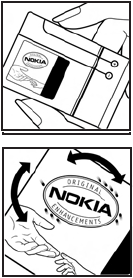
52
Battery and charger information
Improper battery use may result in a fire, explosion, or other hazard. If the device or battery
is dropped, especially on a hard surface, and you believe the battery has been damaged, take
it to a service center for inspection before continuing to use it.
Use the battery only for its intended purpose. Never use any charger or battery that is
damaged. Keep your battery out of the reach of small children.
■Nokia battery authentication guidelines
Always use original Nokia batteries for your safety. To check that you are getting an original
Nokia battery, purchase it from an authorized Nokia dealer, and inspect the hologram label
using the following steps:
Successful completion of the steps is not a total assurance of the authenticity of the battery.
If you have any reason to believe that your battery is not an authentic, original Nokia
battery, you should refrain from using it, and take it to the nearest authorized Nokia service
point or dealer for assistance. Your authorized Nokia service point or dealer will inspect the
battery for authenticity. If authenticity cannot be verified, return the battery to the place of
purchase.
Authenticate hologram
1. When you look at the hologram on the label, you should
see the Nokia connecting hands symbol from one angle and
the Nokia Original Enhancements logo when looking from
another angle.
2. When you angle the hologram left, right, down and up, you
should see 1, 2, 3 and 4 dots on each side respectively.
What if your battery is not authentic?
If you cannot confirm that your Nokia battery with the hologram on the label is an authentic
Nokia battery, please do not use the battery. Take it to the nearest authorized Nokia service
point or dealer for assistance. The use of a battery that is not approved by the manufacturer
may be dangerous and may result in poor performance and damage to your device and its
enhancements. It may also invalidate any approval or warranty applying to the device.
To find out more about original Nokia batteries, visit www.nokia.com/battery or
www.latinoamerica.nokia.com/verifiquesubateria.
RM429_NAMLTA630.fm Page 52 Monday, June 30, 2008 2:34 PM
FCC Draft

53
Care and maintenance
Care and maintenance
Your device is a product of superior design and craftsmanship and should be treated with
care. The following suggestions will help you protect your warranty coverage.
• Keep the device dry. Precipitation, humidity, and all types of liquids or moisture can
contain minerals that will corrode electronic circuits. If your device does get wet, remove
the battery, and allow the device to dry completely before replacing it.
• Do not use or store the device in dusty, dirty areas. Its moving parts and electronic
components can be damaged.
• Do not store the device in hot areas. High temperatures can shorten the life of electronic
devices, damage batteries, and warp or melt certain plastics.
• Do not store the device in cold areas. When the device returns to its normal temperature,
moisture can form inside the device and damage electronic circuit boards.
• Do not attempt to open the device other than as instructed in this guide.
• Do not drop, knock, or shake the device. Rough handling can break internal circuit boards
and fine mechanics.
• Do not use harsh chemicals, cleaning solvents, or strong detergents to clean the device.
• Do not paint the device. Paint can clog the moving parts and prevent proper operation.
• Use a soft, clean, dry cloth to clean any lenses, such as camera, proximity sensor, and
light sensor lenses.
• Use only the supplied or an approved replacement antenna. Unauthorized antennas,
modifications, or attachments could damage the device and may violate regulations
governing radio devices.
• Use chargers indoors.
• Always create a backup of data you want to keep, such as contacts and calendar notes.
• To reset the device from time to time for optimum performance, power off the device
and remove the battery.
These suggestions apply equally to your device, battery, charger, or any enhancement. If any
device is not working properly, take it to the nearest authorized service facility for service.
RM429_NAMLTA630.fm Page 53 Monday, June 30, 2008 2:34 PM
FCC Draft

54
Additional safety information
Disposal
The crossed-out wheeled-bin symbol on your product, literature, or packaging
reminds you that in the European Union all electrical and electronic products,
batteries, and accumulators must be taken to separate collection at the end of their
working life. Do not dispose of these products as unsorted municipal waste.
By returning the products to collection you help prevent uncontrolled waste disposal
and promote the reuse of material resources. More detailed information is available
from the product retailer, local waste authorities, national producer responsibility
organizations, or your local Nokia representative. For the product Eco-Declaration or
instructions for returning your obsolete product, go to country-specific information
at www.nokia.com.
Additional safety information
■Small children
Your device and its enhancements may contain small parts. Keep them out of the reach of
small children.
■Operating environment
This device meets RF exposure guidelines when used either in the normal use position
against the ear or when positioned at least 2.2 centimeters (7/8 inch) away from the body.
When a carry case, belt clip, or holder is used for body-worn operation, it should not contain
metal and should position the device the above-stated distance from your body.
To transmit data files or messages, this device requires a quality connection to the network.
In some cases, transmission of data files or messages may be delayed until such a
connection is available. Ensure the above separation distance instructions are followed until
the transmission is completed.
■Medical devices
Operation of any radio transmitting equipment, including wireless phones, may interfere
with the functionality of inadequately protected medical devices. Consult a physician or the
manufacturer of the medical device to determine if they are adequately shielded from
external RF energy or if you have any questions. Switch off your device in health care
facilities when any regulations posted in these areas instruct you to do so. Hospitals or
health care facilities may be using equipment that could be sensitive to external RF energy.
Implanted medical devices
Manufacturers of medical devices recommend that a minimum separation of 15.3
centimeters (6 inches) should be maintained between a wireless device and an implanted
medical device, such as a pacemaker or implanted cardioverter defibrillator, to avoid
potential interference with the medical device. Persons who have such devices should:
RM429_NAMLTA630.fm Page 54 Monday, June 30, 2008 2:34 PM
FCC Draft

55
Additional safety information
• Always keep the wireless device more than 15.3 centimeters (6 inches) from the medical
device when the wireless device is turned on.
• Not carry the wireless device in a breast pocket.
• Hold the wireless device to the ear opposite the medical device to minimize the potential
for interference.
• Turn the wireless device off immediately if there is any reason to suspect that
interference is taking place.
• Read and follow the directions from the manufacturer of their implanted medical device.
If you have any questions about using your wireless device with an implanted medical device
consult your health care provider.
Hearing aids
Some digital wireless devices may interfere with some hearing aids. If interference occurs,
consult your service provider.
Warning: For hearing aid compatibility, you must turn off the Bluetooth
connectivity.
Your mobile device model complies with FCC rules governing hearing aid compatibility.
These rules require an M3 microphone or higher value. The M-value, shown on the device
box, refers to lower radio frequency (RF) emissions. A higher M-value generally indicates
that a device model has a lower RF emissions level, which may improve the likelihood that
the device will operate with certain hearing aids. Some hearing aids are more immune than
others to interference. Please consult your hearing health professional to determine the M-
rating of your hearing aid and whether your hearing aid will work with this device. More
information on accessibility can be found at www.nokiaaccessibility.com.
■Vehicles
RF signals may affect improperly installed or inadequately shielded electronic systems in
motor vehicles such as electronic fuel injection systems, electronic antiskid (antilock)
braking systems, electronic speed control systems, and air bag systems. For more
information, check with the manufacturer, or its representative, of your vehicle or any
equipment that has been added.
Only qualified personnel should service the device or install the device in a vehicle. Faulty
installation or service may be dangerous and may invalidate any warranty that may apply to
the device. Check regularly that all wireless device equipment in your vehicle is mounted
and operating properly. Do not store or carry flammable liquids, gases, or explosive materials
in the same compartment as the device, its parts, or enhancements. For vehicles equipped
with an air bag, remember that air bags inflate with great force. Do not place objects,
including installed or portable wireless equipment in the area over the air bag or in the air
bag deployment area. If in-vehicle wireless equipment is improperly installed and the air bag
inflates, serious injury could result.
RM429_NAMLTA630.fm Page 55 Monday, June 30, 2008 2:34 PM
FCC Draft

56
Additional safety information
Using your device while flying in aircraft is prohibited. Switch off your device before
boarding an aircraft. The use of wireless teledevices in an aircraft may be dangerous to the
operation of the aircraft, disrupt the wireless telephone network, and may be illegal.
■Potentially explosive environments
Switch off your device when in any area with a potentially explosive atmosphere, and obey
all signs and instructions. Potentially explosive atmospheres include areas where you would
normally be advised to turn off your vehicle engine. Sparks in such areas could cause an
explosion or fire resulting in bodily injury or even death. Switch off the device at refuelling
points such as near gas pumps at service stations. Observe restrictions on the use of radio
equipment in fuel depots, storage, and distribution areas; chemical plants; or where blasting
operations are in progress. Areas with a potentially explosive atmosphere are often, but not
always, clearly marked. They include below deck on boats, chemical transfer or storage
facilities and areas where the air contains chemicals or particles such as grain, dust, or metal
powders. You should check with the manufacturers of vehicles using liquefied petroleum gas
(such as propane or butane) to determine if this device can be safely used in their vicinity.
■Emergency calls
Important: This device operates using radio signals, wireless networks, landline
networks, and user-programmed functions. If your device supports voice calls over
the internet (internet calls), activate both the internet calls and the cellular phone.
The device will attempt to make emergency calls over both the cellular networks
and through your internet call provider if both are activated. Connections in all
conditions cannot be guaranteed. You should never rely solely on any wireless
device for essential communications like medical emergencies.
To make an emergency call:
1. If the device is not on, switch it on. Check for adequate signal strength. Depending on
your device, you may also need to complete the following:
• Insert a SIM card if your device uses one.
• Remove certain call restrictions you have activated in your device.
• Change your profile from offline or flight profile mode to an active profile.
2. Press the end key as many times as needed to clear the display and ready the device for
calls.
3. Enter the official emergency number for your present location. Emergency numbers vary
by location.
4. Press the call key.
When making an emergency call, give all the necessary information as accurately as
possible. Your wireless device may be the only means of communication at the scene of an
accident. Do not end the call until given permission to do so.
RM429_NAMLTA630.fm Page 56 Monday, June 30, 2008 2:34 PM
FCC Draft
57
Additional safety information
■Certification information (SAR)
This mobile device meets guidelines for exposure to radio waves
Your mobile device is a radio transmitter and receiver. It is designed not to exceed the limits
for exposure to radio waves recommended by international guidelines. These guidelines
were developed by the independent scientific organization ICNIRP and include safety
margins designed to assure the protection of all persons, regardless of age and health.
The exposure guidelines for mobile devices employ a unit of measurement known as the
Specific Absorption Rate or SAR. The SAR limit stated in the ICNIRP guidelines is 2.0 watts/
kilogram (W/kg) averaged over 10 grams of tissue. Tests for SAR are conducted using
standard operating positions with the device transmitting at its highest certified power level
in all tested frequency bands. The actual SAR level of an operating device can be below the
maximum value because the device is designed to use only the power required to reach the
network. That amount changes depending on a number of factors such as how close you are
to a network base station. The highest SAR value under the ICNIRP guidelines for use of the
device at the ear is 0.95 W/kg.
Use of device accessories and enhancements may result in different SAR values. SAR values
may vary depending on national reporting and testing requirements and the network band.
Additional SAR information may be provided under product information at www.nokia.com.
Your mobile device is also designed to meet the requirements for exposure to radio waves
established by the Federal Communications Commission (USA) and Industry Canada. These
requirements set a SAR limit of 1.6 W/kg averaged over one gram of tissue. The highest SAR
value reported under this standard during product certification for use at the ear is 0.83 W/
kg and when properly worn on the body is 0.83 W/kg.
RM429_NAMLTA630.fm Page 57 Monday, June 30, 2008 2:34 PM
FCC Draft
58
Index
A
access codes 10
active standby 17, 31
alarm clock 43
antenna 13
applications
audio messages 23
B
battery 12
Bluetooth 32, 50
bookmarks 47
browser 47
business cards 29
C
calculator 44
calendar 43
call
key 14
log 30
options 20
settings 36
waiting 20
call register. See call log.
calls 18, 19
camera
effects 40
filter 40
settings 40
character case 20
codes 10
configuration 37
setting service 10
contact information 11
contacts 28, 29
cookies 47
customer service 11
D
data
communication 50
data cable 35
display 16
downloads 11
E
EGPRS 34
e-mail application 24
emergency calls 56
end
call 18
end key 14
equalizer 42
F
factory settings 38
flash messages 23
font size 31
G
gallery 39
games 45
GPRS 34
H
handsfree. See loudspeaker. 20
I
indicators 17
instant messaging 25
internet 46
K
keyguard 10
keypad lock 10
L
language settings 36
locking the keypad 10
log 30
loudspeaker 20
M
message settings 25, 26, 27
messages
audio messages 23
flash messages 23
length indicator 21
RM429_NAMLTA630.fm Page 58 Monday, June 30, 2008 2:34 PM
FCC Draft
59
message settings 25
voice message 25
mini display 31
MMS. See multimedia messages. 22
multimedia messages 22
music player 41
N
notes 43, 44
O
operator menu 39
P
packet data 34
PC Suite 50
phone
configuration 37
settings 36
PictBridge 35
power key 13, 14
predictive text input 21
profiles 30
PTT 40
Push to talk. See PTT.
R
recorder 42
ringing tones 31
S
safety information 54
SAR 56
security
module 48
settings 38
services 46
settings
call 36
camera 40
configuration 37
connectivity 32
data transfer 34
GPRS, EGPRS 34
messages 25
my shortcuts 32
phone 36
profiles 30
restore factory settings 38
security 38
service inbox 48
themes 30
tones 31
USB data cable 35
wallpaper 31
shortcuts 32
signal strength 16
software updates 11
speed dialling 19, 30
standby mode 16, 32
stopwatch 45
switch on and off 13
synchronization 34
T
text 20, 21
themes 30
to-do list 44
tones 31
traditional text input 21
U
unlocking the keypad 10
V
voice
commands 32
dialling 19
messages 25
recorder 42
W
wallpaper 31
Web 46
web 46
write text 20
RM429_NAMLTA630.fm Page 59 Monday, June 30, 2008 2:34 PM
FCC Draft